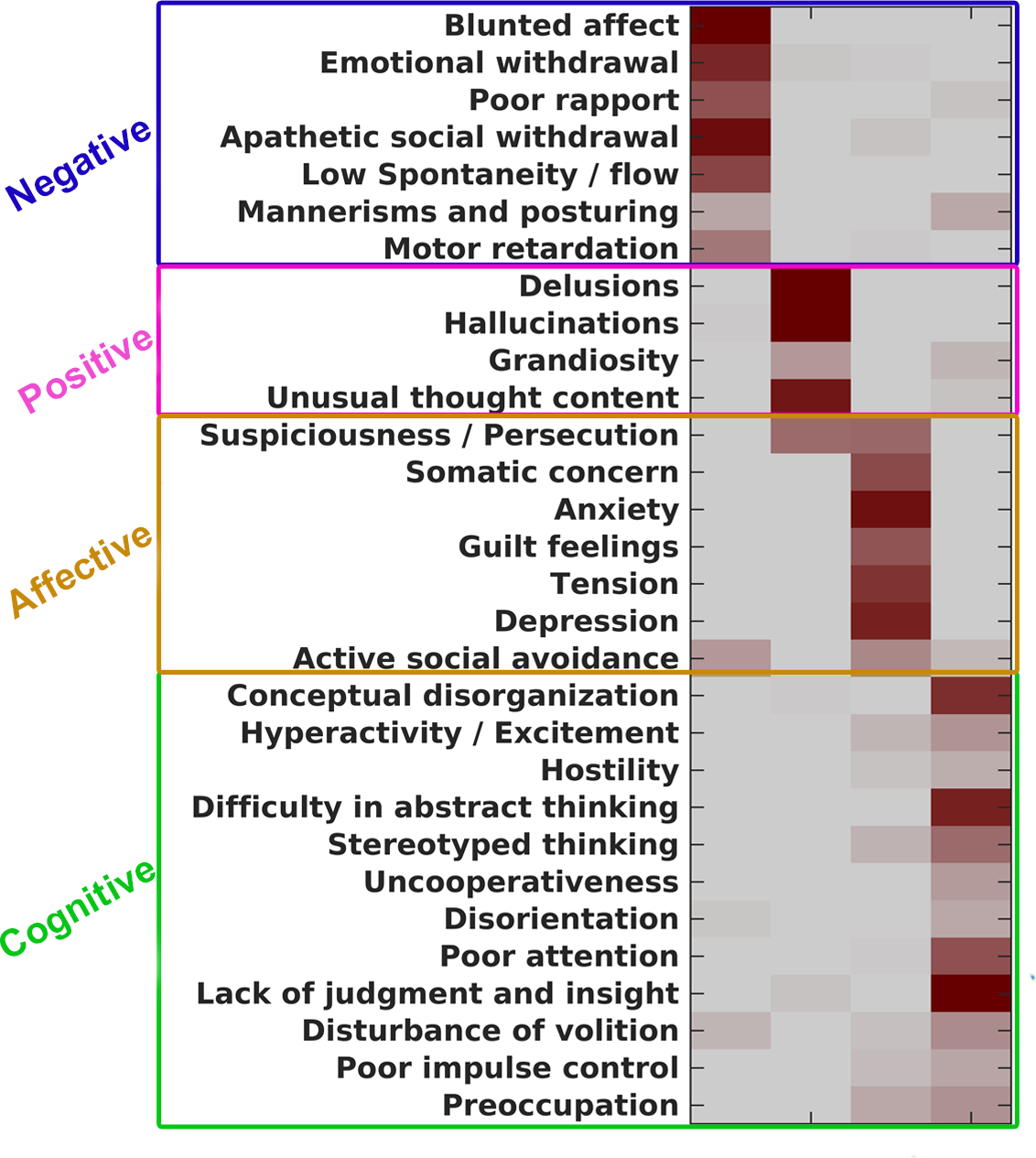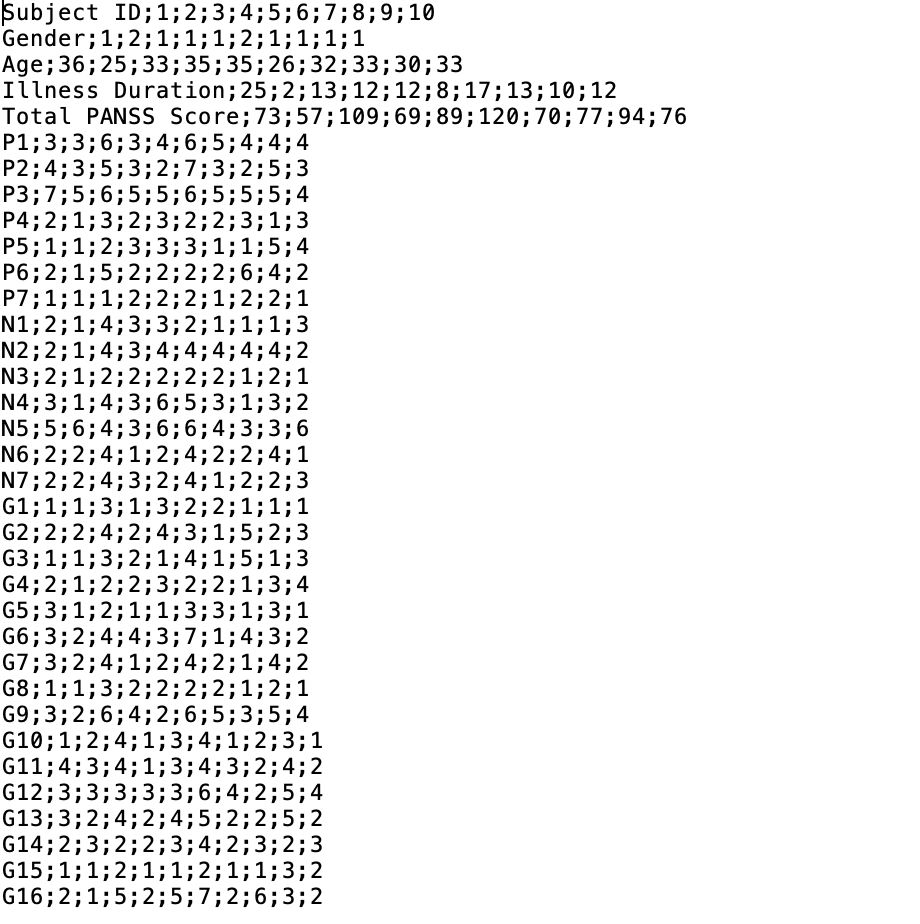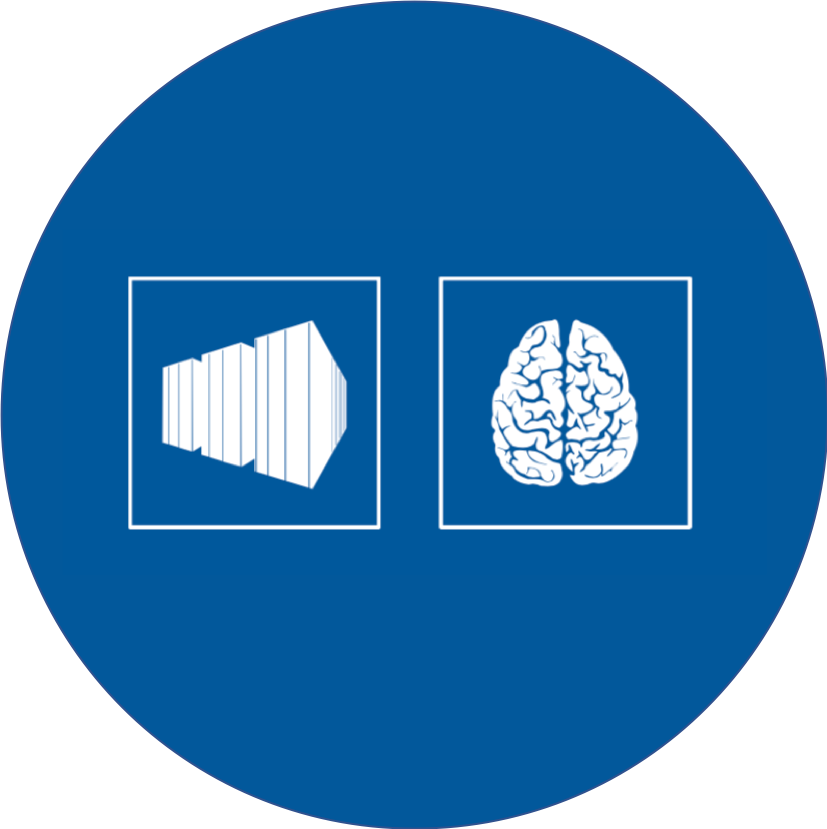Description
Schizophrenia is a heterogeneous syndrome and the patients display marked interindividual variability in their psychopathology. This makes individual’s symptom expressions are difficult to explain. Grouping co-expressed symptoms into specific dimensions and categorizing patients into symptomatically distinct subgroups could effectively resolve the complexities and illuminate a way to disentangle the heterogeneity. Our dimensions and clustering tool provides such an assessment of symptomatology for individual schizophrenia patients towards a hybrid categorical-dimensional conceptualization.
Dimensions Tool
The current four dimensions, representing negative, positive, affective, cognitive symptomatology, were identified based on factorizing the Positive and Negative Syndrome Scale (PANSS) in a large Pharmacotherapy Monitoring and Outcome Survey (PHAMOUS) cohort using an orthogonal and projective variant of non-negative matrix factorization (OPNMF). This model has been cross-validated in an international sample — pooled from nine centers located in Europe, the USA and Asia covering a broad range of clinical states and settings — to demonstrate its stability and generalizability.
Note: You can upload a csv file with multiple subjects’ PANSS data by clicking the below "Choose File" button. Then, the results, i.e., factor scores, which reflect symptom severity on the four dimensions, can be either downloaded or shown in a new tab. The file must be formatted in a specific way, please have a look at the example upload file.


Output:
Options
Clustering Tool
The clustering tool assigns patients to either the negative, positive or symptomatically ambiguous class based on their symptomatic expressions on the four dimensions as derived from the dimensions tool. To execute this step, demographic variables (gender and age) and illness duration information must be provided as the clustering happens based on the residuals of the factor-scores. The factor-scores will be adjusted by using the betas obtained from the international sample. Subgroup assignments of the patients are based on their highest membership degrees pertaining to the two cluster centroids (i.e., the negative and positive subgroups) generated from the international sample. Of note, patients with a membership degree lower than 0.7 are assigned to the ambiguous class. The cutoff was carefully selected based on evidence from both fuzzy c-means and Gaussian mixture modeling.
Note:
As the cutoff 0.7 is heuristic for determining the
ambiguous class, we also output the membership degree
values for the input patients.
Output:
References
References for the model and tool:
- Chen J, Patil KR, Weis S, Sim K, Nickl-Jockschat T, Zhou J, et al. (2019): Neurobiological divergence of the positive and negative schizophrenia subtypes identified upon a new factor-structure of psychopathology using non-negative factorization: An international machine-learning study. Biological Psychiatry.
Contact: Ji Chen (j.chen@fz-juelich.de)
References for the PHAMOUS cohort:
- Bartels-Velthuis AA, Visser E, Arends J, Pijnenborg GHM, Wunderink L, Jörg F, et al. (2018): Towards a comprehensive routine outcome monitoring program for people with psychotic disorders: The Pharmacotherapy Monitoring and Outcome Survey (PHAMOUS). Schizophr Res 197: 281-287.
- Liemburg EJ, Nolte IM, Klein HC, Knegtering H (2018): Relation of inflammatory markers with symptoms of psychotic disorders: a large cohort study. Prog Neuropsychopharmacol Biol Psychiatry 86: 89-94.
References for OPNMF:
- Yang Z, Oja E (2010): Linear and nonlinear projective nonnegative matrix factorization. IEEE Trans Neural Netw 21: 734-749.
- Varikuti DP, Genon S, Sotiras A, et al. (2018): Evaluation of non-negative matrix factorization of grey matter in age prediction. NeuroImage 173: 394-410.
- Sotiras A, Resnick SM, Davatzikos C. (2015): Finding imaging patterns of structural covariance via non-negative matrix factorization. NeuroImage 108: 1-16.
- Sotiras A, Toledo JB, Gur RE, Gur RC, Satterthwaite TD, Davatzikos C. (2017): Patterns of coordinated cortical remodeling during adolescence and their associations with functional specialization and evolutionary expansion. Proc Natl Acad Sci U S A 114: 3527-3532.
Disclaimer
This tool is provided by Forschungszentrum Jülich exclusively for convenience. It is intended to be used for research purposes only. It is neither a substitute for clinical experience or expertise nor can this electronic tool assess the clinical picture or patient-specific factors. Absolutely NO information and results from this tool are intended to be used for the diagnosis of diseases or any other conditions, or in the cure, mitigation, treatment, or prevention of diseases.
Forschungszentrum Jülich provides no warranty for correctness or usability in any scientific, clinical context, commercial or any other context. Instead, all information provided by this tool should be validated by the user himself or herself. Forschungszentrum Jülich cannot exclude that using this tool violates any right of any third party.
Forschungszentrum Jülich assumes no liability of any kind for the information provided by this tool, in particular Forschungszentrum Jülich assumes no liability for any direct, indirect, incidental, special, exemplary damages or any consequential damages which result from using this tool. This does not apply to damage caused by Forschungszentrum Jülich intentionally.
Forschungszentrum Jülich provides no warranty that this tool is free from any virus, worm, malware, Trojan or any other malicious code which may cause damage to or control data, software or hardware of the user.
Forschungszentrum Jülich is not obliged to update this tool. In case of an update, Forschungszentrum Jülich assumes no liability for any damages caused by the update.


